Prebiotic Chemistry of Phosphite: Mild Thermal Routes to Form Condensed-P Energy Currency Molecules Leading Up to the Formation of Organophosphorus Compounds
Abstract
1. Introduction
2. Materials and Methods
2.1. Synthesis of Inorganic Condensed P Compounds through Wet–Dry Cycles
2.2. Synthesis of Inorganic Condensed P under ‘Warm-Pool Model’ Theme
2.3. Synthesis of Organophosphites from the Reactive Condensed P through Wet–Dry Cycles
2.4. Analyses and Characterization of Inorganic and Organic P Compounds
3. Results
4. Discussion
Supplementary Materials
Author Contributions
Funding
Institutional Review Board Statement
Informed Consent Statement
Data Availability Statement
Acknowledgments
Conflicts of Interest
References
- Pasek, M.A. Rethinking early Earth phosphorus geochemistry. Proc. Natl. Acad. Sci. USA 2008, 105, 853–858. [Google Scholar] [CrossRef] [PubMed]
- Schwartz, A.W. Phosphorus in prebiotic chemistry. Philos. Trans. R. Soc. Lond. B Biol. Sci. 2006, 361, 1743–1749. [Google Scholar] [CrossRef]
- Kring, D.A.; Cohen, B.A. Cataclysmic bombardment throughout the inner solar system 3.9–4.0 Ga. J. Geophys. Res. Planets 2002, 107, 4-1. [Google Scholar] [CrossRef]
- Strom, R.G.; Malhotra, R.; Ito, T.; Yoshida, F.; Kring, D.A. The origin of planetary impactors in the inner solar system. Science 2005, 309, 1847–1850. [Google Scholar] [CrossRef] [PubMed]
- Maciá, E.; Hernández, M.V.; Oró, J. Primary sources of phosphorus and phosphates in chemical evolution. Orig. Life Evol. Biosph. 1997, 27, 459–480. [Google Scholar] [CrossRef]
- Pasek, M.; Lauretta, D. Extraterrestrial flux of potentially prebiotic C, N, and P to the early Earth. Orig. Life Evol. Biosph. 2008, 38, 5–21. [Google Scholar] [CrossRef]
- Pasek, M.A.; Lauretta, D.S. Aqueous corrosion of phosphide minerals from iron meteorites: A highly reactive source of prebiotic phosphorus on the surface of the early Earth. Astrobiology 2005, 5, 515–535. [Google Scholar] [CrossRef]
- Pasek, M.A.; Dworkin, J.P.; Lauretta, D.S. A radical pathway for organic phosphorylation during schreibersite corrosion with implications for the origin of life. Geochim. Cosmochim. Acta 2007, 71, 1721–1736. [Google Scholar] [CrossRef]
- Ritson, D.J.; Mojzsis, S.J.; Sutherland, J.D. Supply of phosphate to early Earth by photogeochemistry after meteoritic weathering. Nat. Geosci. 2020, 13, 344–348. [Google Scholar] [CrossRef]
- Pasek, M.A. Schreibersite on the early Earth: Scenarios for prebiotic phosphorylation. Geosci. Front. 2017, 8, 329–335. [Google Scholar] [CrossRef]
- Melosh, H.J. Impact Cratering: A Geologic Process, 1st ed.; Oxford University Press: New York, NY, USA, 1989. [Google Scholar]
- Simonson, B.M.; Glass, B.P. Spherule layers—Records of ancient impacts. Annu. Rev. Earth Planet Sci. 2004, 32, 329–361. [Google Scholar] [CrossRef]
- Hunter, R.H.; Taylor, L.A. Rust and schreibersite in Apollo 16 highland rocks-Manifestations of volatile-element mobility. In Proceedings of the 12th Lunar and Planetary Science Conference, Houston, TX, USA, 16–20 March 1981; Pergamon Press: New York, NY, USA, 1982; Volume 12, pp. 253–259. [Google Scholar]
- Yakovlev, O.I.; Dikov, Y.P.; Gerasimov, M.V. Experimental data on the thermal reduction of phosphorus and iron and their significance for the interpretation of the impact reworking of lunar materials. Geochem. Int. 2006, 44, 847. [Google Scholar] [CrossRef]
- Cooper, G.W.; Onwo, W.M.; Cronin, J.R. Alkyl phosphonic acids and sulfonic acids in the Murchison meteorite. Geochim. Cosmochim. Acta 1992, 56, 4109–4115. [Google Scholar] [CrossRef] [PubMed]
- Pasek, M.A.; Harnmeijer, J.P.; Buick, R.; Gull, M.; Atlas, Z. Evidence for reactive reduced phosphorus species in the early Archean Ocean. Proc. Natl. Acad. Sci. USA 2013, 110, 10089–10094. [Google Scholar] [CrossRef]
- Pasek, M.; Block, K. Lightning-induced reduction of phosphorus oxidation state. Nat. Geosci. 2009, 2, 553–556. [Google Scholar] [CrossRef]
- Pech, H.; Henry, A.; Khachikian, C.S.; Salmassi, T.M.; Hanrahan, G.; Foster, K.L. Detection of geothermal phosphite using high-performance liquid chromatography. Environ. Sci. Technol. 2009, 43, 7671–7675. [Google Scholar] [CrossRef]
- Pasek, M.A.; Sampson, J.M.; Atlas, Z. Redox chemistry in the phosphorus biogeochemical cycle. Proc. Natl. Acad. Sci. USA 2014, 111, 15468–15473. [Google Scholar] [CrossRef]
- Pasek, M.A.; Gull, M.; Herschy, B. Phosphorylation on the early earth. Chem. Geol. 2017, 475, 149–170. [Google Scholar] [CrossRef]
- Gulick, A. Phosphorus as a factor in the origin of life. Am. Sci. 1955, 43, 479–489. [Google Scholar]
- Pasek, M.A.; Kee, T.P. On the origin of phosphorylated biomolecules. In Origins of Life: The Primal Self-Organization, 1st ed.; Egel, R., Lankenau, D.-H., Mulkidjanian, A.Y., Eds.; Springer: Berlin, Germany, 2011; pp. 57–84. [Google Scholar]
- Gull, M. Prebiotic Phosphorylation Reactions on the Early Earth. Challenges 2014, 5, 193–212. [Google Scholar] [CrossRef]
- Gull, M.; Mojica, M.A.; Fernández, F.M.; Gaul, D.A.; Orlando, T.M.; Liotta, C.L.; Pasek, M.A. Nucleoside phosphorylation by the mineral schreibersite. Sci. Rep. 2015, 5, 17198. [Google Scholar] [CrossRef]
- La Cruz, N.L.; Qasim, D.; Abbott-Lyon, H.; Pirim, C.; McKee, A.D.; Orlando, T.; Gull, M.; Lindsay, D.; Pasek, M.A. The evolution of the surface of the mineral schreibersite in prebiotic chemistry. Phys. Chem. Chem. Phys. 2016, 18, 20160–20167. [Google Scholar] [CrossRef] [PubMed]
- Gull, M.; Feng, T.; Pasek, M.A. Results of an Eight-Year Extraction of Phosphorus Minerals within the Seymchan Meteorite. Life 2022, 12, 1591. [Google Scholar] [CrossRef]
- Kee, T.P.; Bryant, D.E.; Herschy, B.; Marriott, K.E.; Cosgrove, N.E.; Pasek, M.A.; Atlas, Z.D.; Cousins, C.R. Phosphate activation via reduced oxidation state phosphorus (P). Mild routes to condensed-P energy currency molecules. Life 2013, 3, 386–402. [Google Scholar] [CrossRef]
- Arrhenius, G.; Sales, B.; Mojzsis, S.; Lee, T. Entropy and charge in molecular evolution—The case of phosphate. J. Theor. Biol. 1997, 187, 503–522. [Google Scholar] [CrossRef] [PubMed]
- Handschuh, G.J.; Lohrmann, R.; Orgel, L.E. The effect of Mg2+ and Ca2+ on urea-catalyzed phosphorylation reactions. J. Mol. Evol. 1973, 2, 251–262. [Google Scholar] [CrossRef] [PubMed]
- Holm, N.G. The significance of Mg in prebiotic geochemistry. Geobiology 2012, 10, 269–279. [Google Scholar] [CrossRef] [PubMed]
- Holm, N.G.; Baltscheffsky, H. Links between hydrothermal environments, pyrophosphate, Na+, and early evolution. Orig. Life Evol. Biosph. 2011, 41, 483–493. [Google Scholar] [CrossRef]
- Yang, J.; Junium, C.K.; Grassineau, N.V.; Nisbet, E.G.; Izon, G.; Mettam, C.; Martin, A.; Zerkle, A.L. Ammonium availability in the Late Archaean nitrogen cycle. Nat. Geosci. 2019, 12, 553–557. [Google Scholar] [CrossRef]
- Gull, M.; Feng, T.; Bracegirdle, J.; Abbott-Lyon, H.; Pasek, M.A. Organophosphorus Compound Formation through the Oxidation of Reduced Oxidation State Phosphorus Compounds on the Hadean Earth. J. Mol. Evol. 2022, 91, 60–75. [Google Scholar] [CrossRef]
- Toner, J.D.; Catling, D.C. A carbonate-rich lake solution to the phosphate problem of the origin of life. Proc. Natl. Acad. Sci. USA 2020, 117, 883–888. [Google Scholar] [CrossRef] [PubMed]
- Schoonen, M.; Smirnov, A.; Cohn, C. A perspective on the role of minerals in prebiotic synthesis. AMBIO A J. Hum. Environ. 2004, 33, 539–551. [Google Scholar] [CrossRef] [PubMed]
- Lambert, J.B.; Gurusamy-Thangavelu, S.A.; Ma, K. The silicate-mediated formose reaction: Bottom-up synthesis of sugar silicates. Science 2010, 327, 984–986. [Google Scholar] [CrossRef] [PubMed]
- Österberg, R.; Orgel, L.E.; Lohrmann, R. Further studies of urea-catalyzed phosphorylation reactions. J. Mol. Evol. 1973, 2, 231–234. [Google Scholar] [CrossRef]
- Lohrmann, R.; Orgel, L.E. Urea-inorganic phosphate mixtures as prebiotic phosphorylating agents. Science 1971, 171, 490–494. [Google Scholar] [CrossRef]
- Gull, M.; Omran, A.; Feng, T.; Pasek, M.A. Silicate-, magnesium ion-, and urea-induced prebiotic phosphorylation of uridine via pyrophosphate; revisiting the hot drying water pool scenario. Life 2020, 10, 122. [Google Scholar] [CrossRef]
- Gull, M.; Zhou, M.; Fernández, F.M.; Pasek, M.A. Prebiotic phosphate ester syntheses in a deep eutectic solvent. J. Mol. Evol. 2014, 78, 109–117. [Google Scholar] [CrossRef]
- Gull, M.; Pasek, M.A. Catalytic Prebiotic Formation of Glycerol Phosphate Esters and an Estimation of Their Steady State Abundance under Plausible Early Earth Conditions. Catalysts 2021, 11, 1384. [Google Scholar] [CrossRef]
- Yoza, N.; Ueda, N.; Nakashima, S. pH-dependence of 31 P-NMR spectroscopic parameters of monofluorophosphate, phosphate, hypophosphate, phosphonate, phosphinate and their dimers and trimers. Fresenius J. Anal. Chem. 1994, 348, 633–638. [Google Scholar] [CrossRef]
- Pasek, M.A. Phosphorus NMR of Natural Samples, 1st ed.; Free Radical Consulting: Seffner, FL, USA, 2018. [Google Scholar]
- Gull, M.; Pasek, M.A. The role of glycerol and its derivatives in the biochemistry of living organisms, and their prebiotic origin and significance in the evolution of life. Catalysts 2021, 11, 86. [Google Scholar] [CrossRef]
- Fujita, T.; Kawaguchi, Y.; Fukuta, T.; Matsuda, H.; Kojima, Y.; Yagishita, K. Effect of pH on conversion of hypophosphite and phosphite to phosphate by wet oxidation. J. Surf. Finish. Soc. Jpn. 2006, 57, 368–372, (In Japanese with English Abstract). [Google Scholar] [CrossRef]
- Sydow, C.; Seiband, C.; Siegle, A.F.; Trapp, O. Phosphorylation in liquid sulfur dioxide under prebiotically plausible conditions. Commun. Chem. 2022, 5, 143. [Google Scholar] [CrossRef] [PubMed]
- Lönnberg, T. Sulfurization of H-phosphonate diesters by elemental sulfur under aqueous conditions. ACS Omega 2017, 2, 5122–5127. [Google Scholar] [CrossRef] [PubMed]
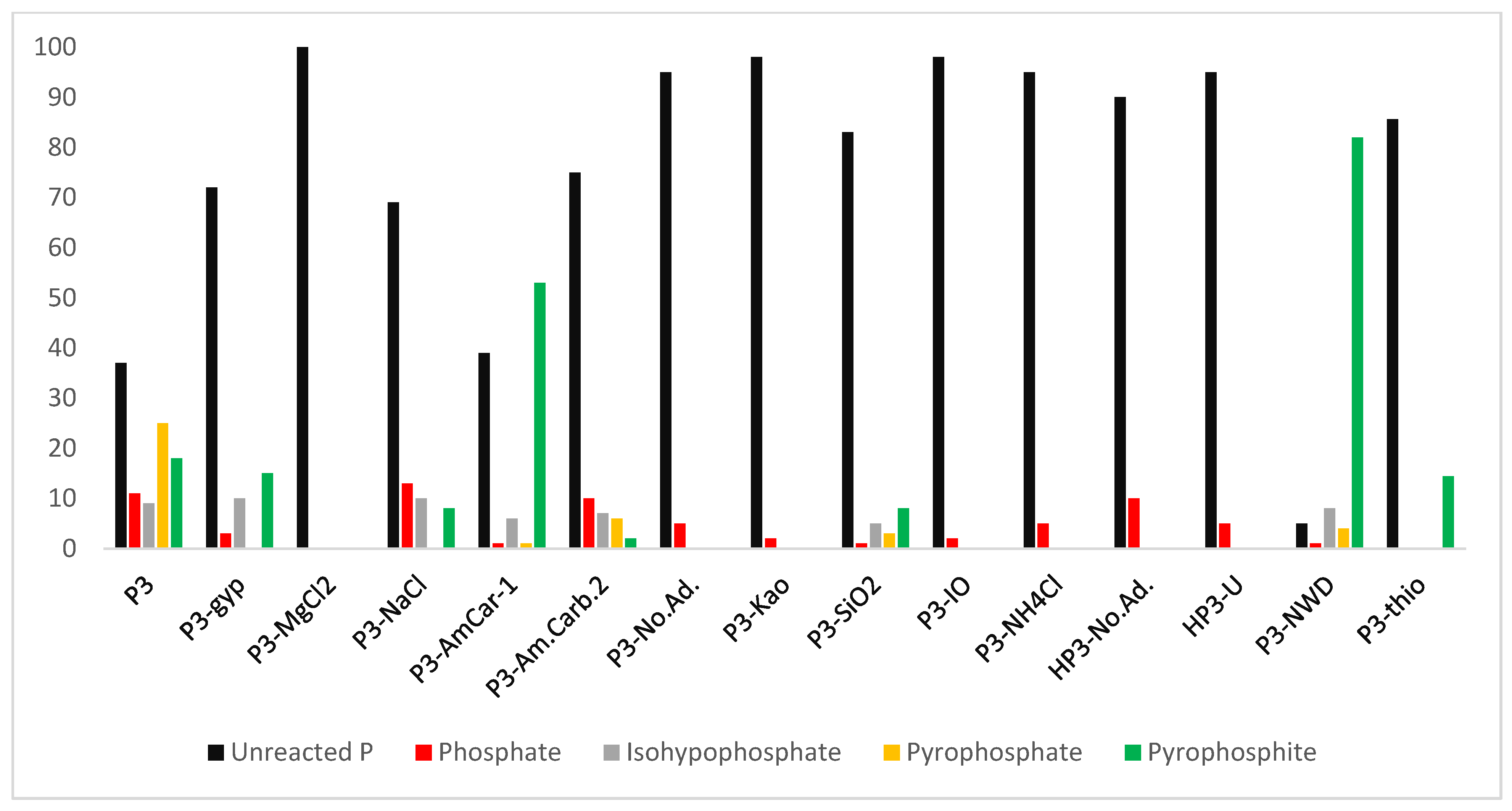
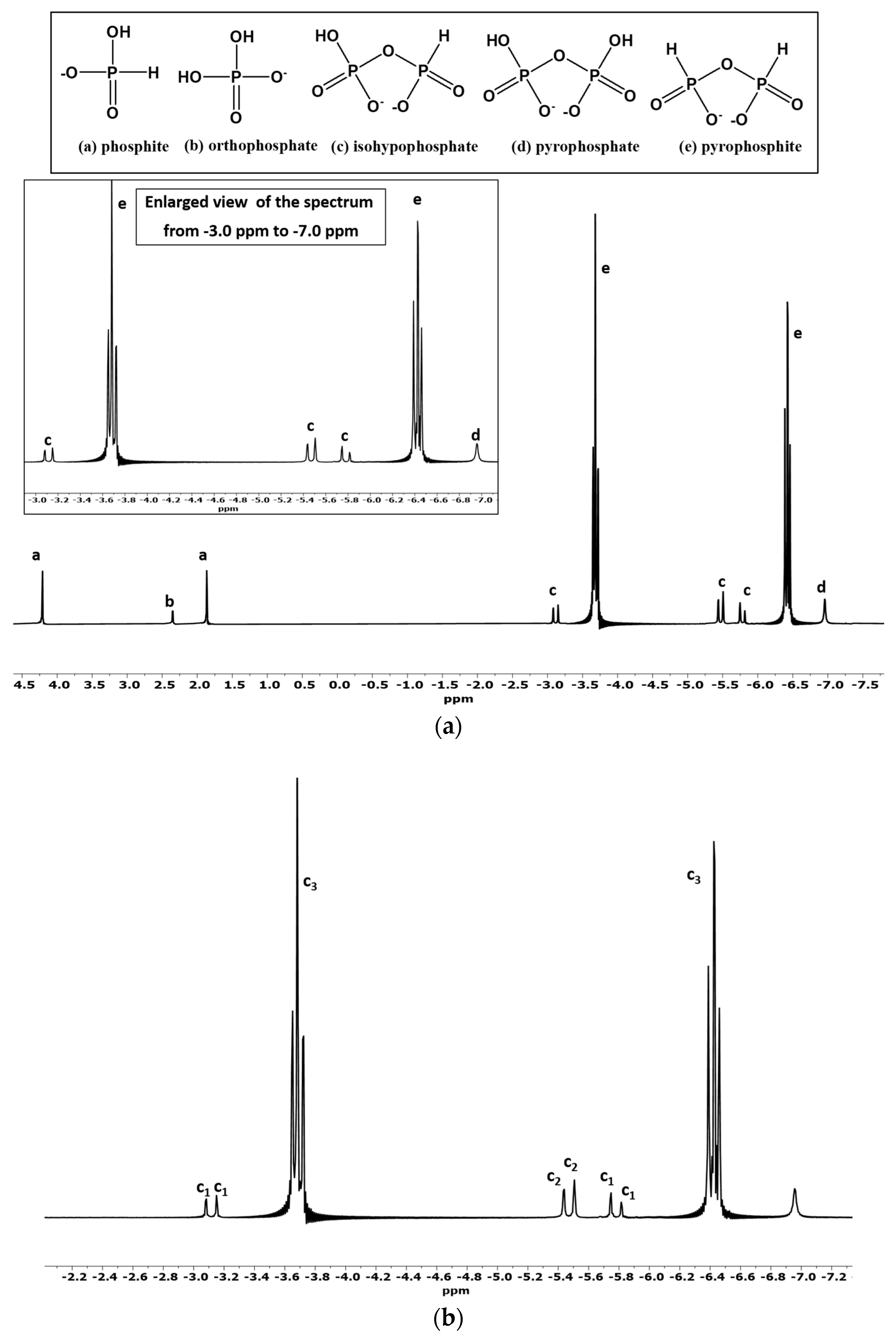
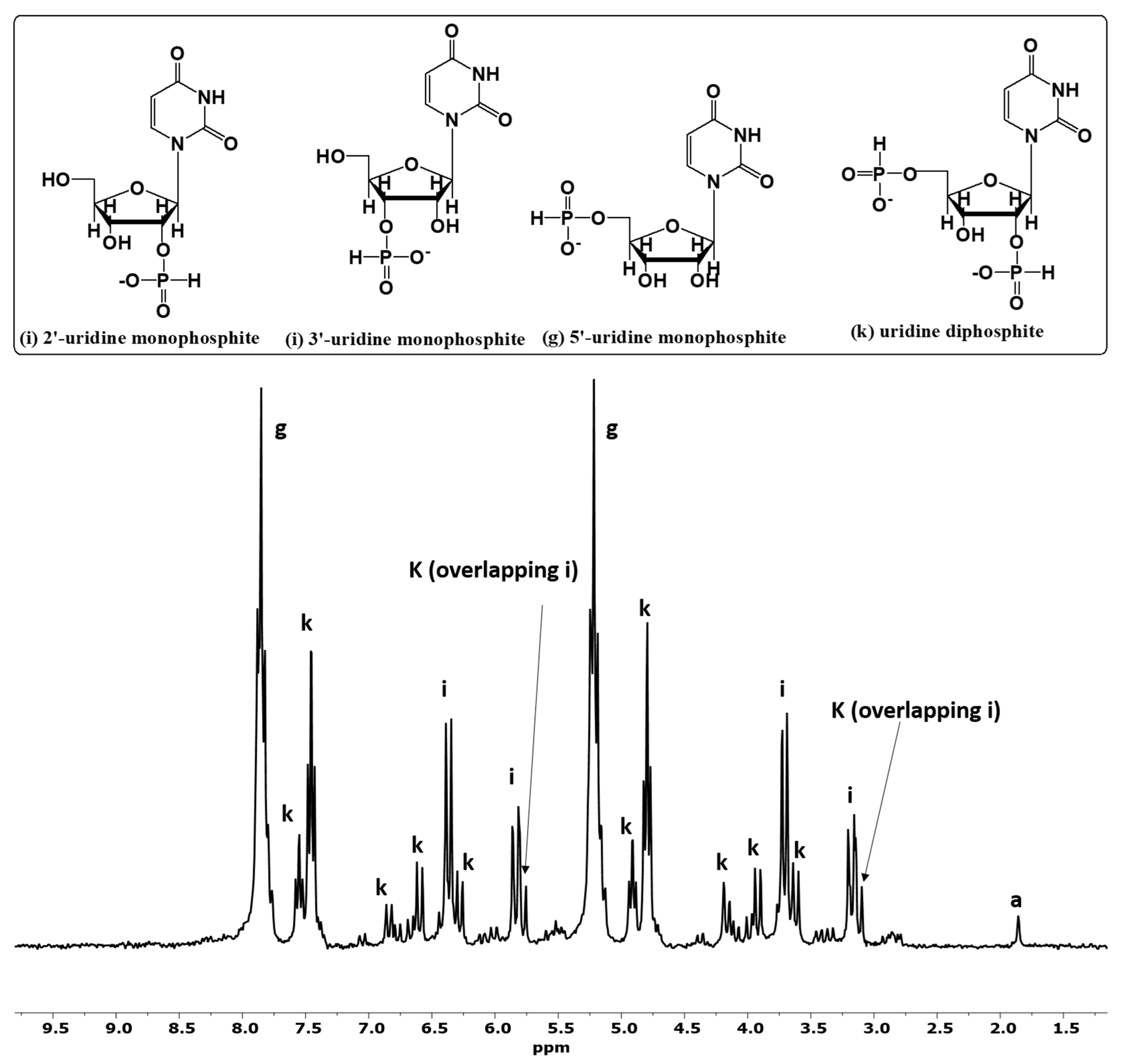
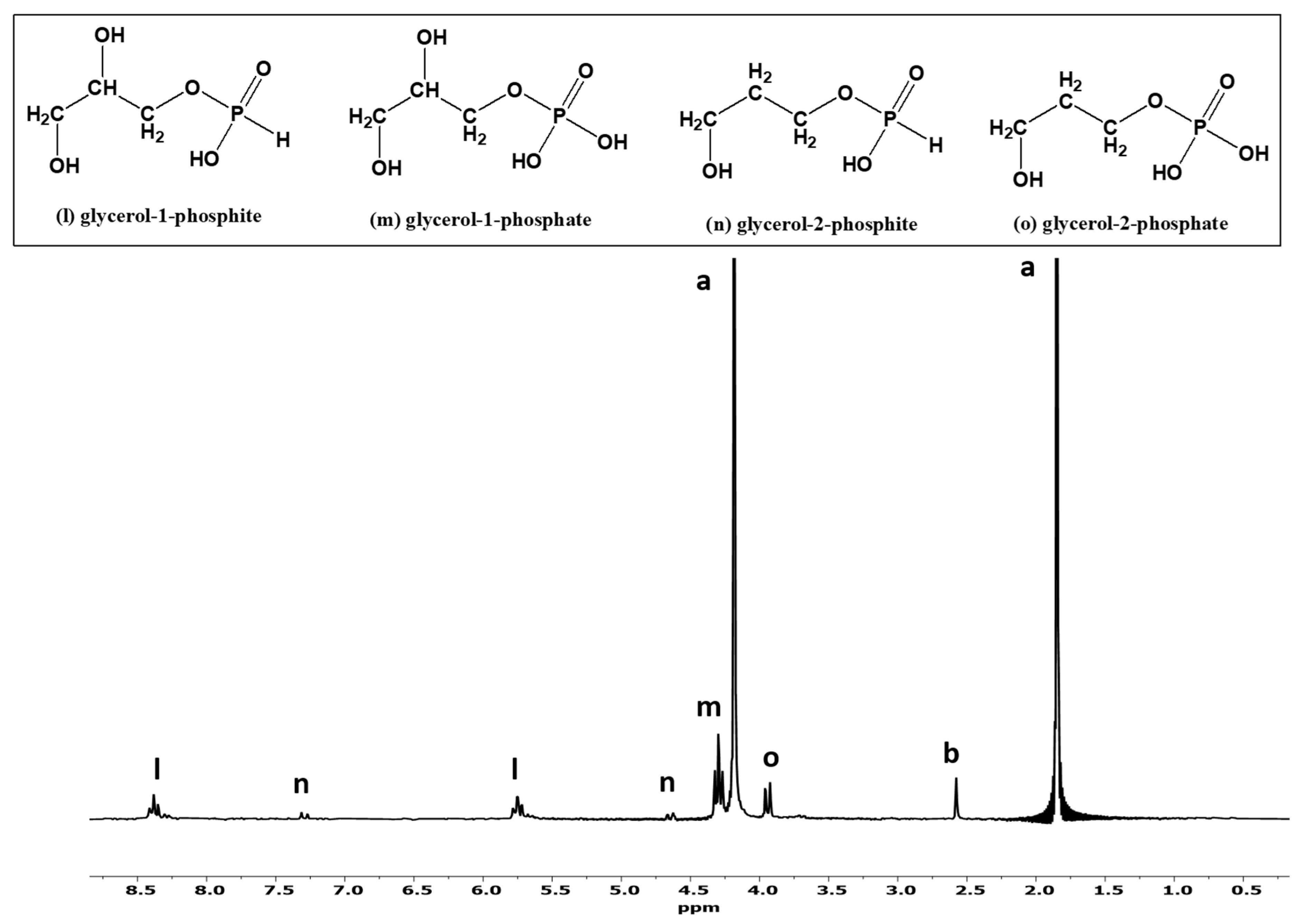
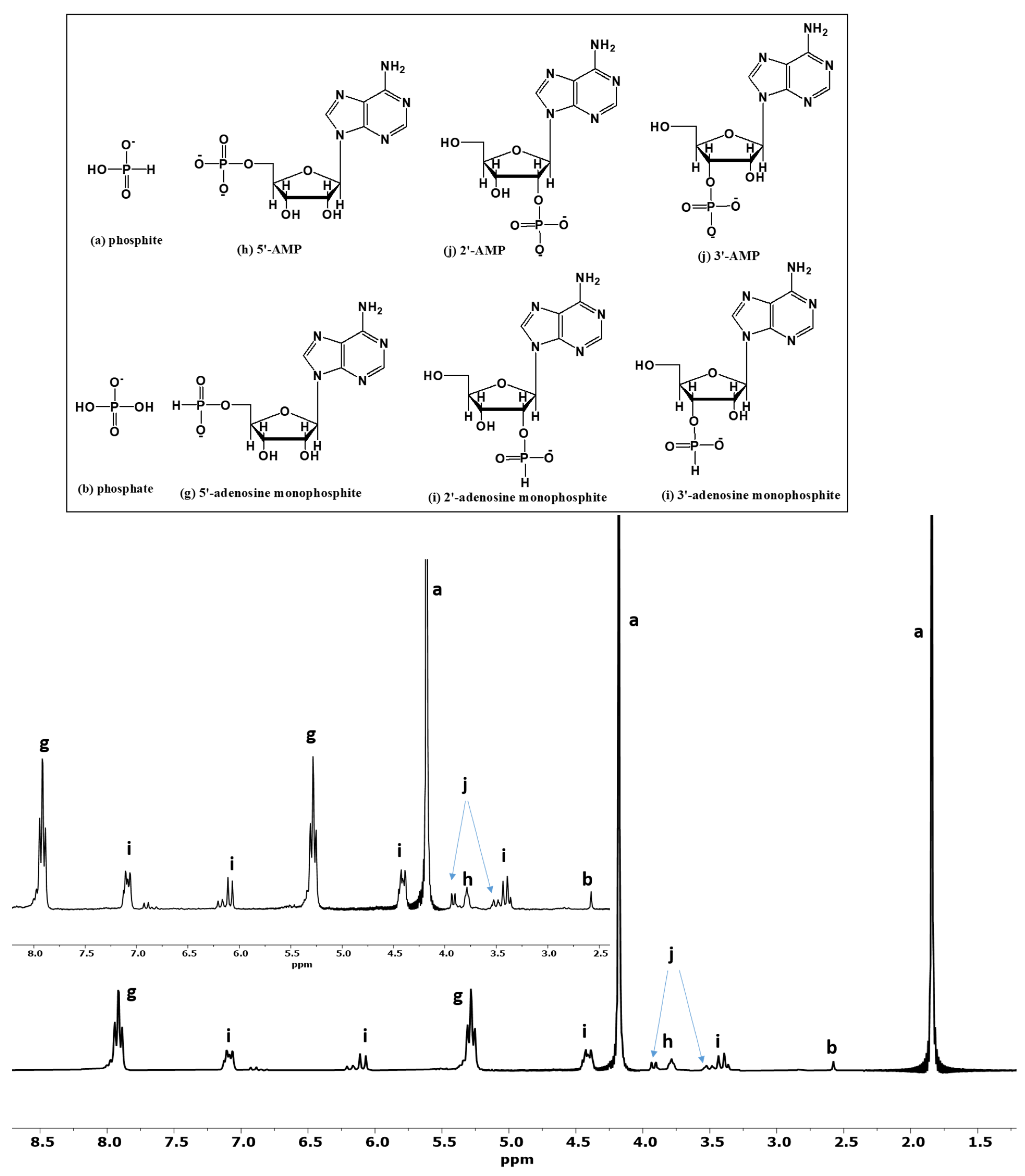

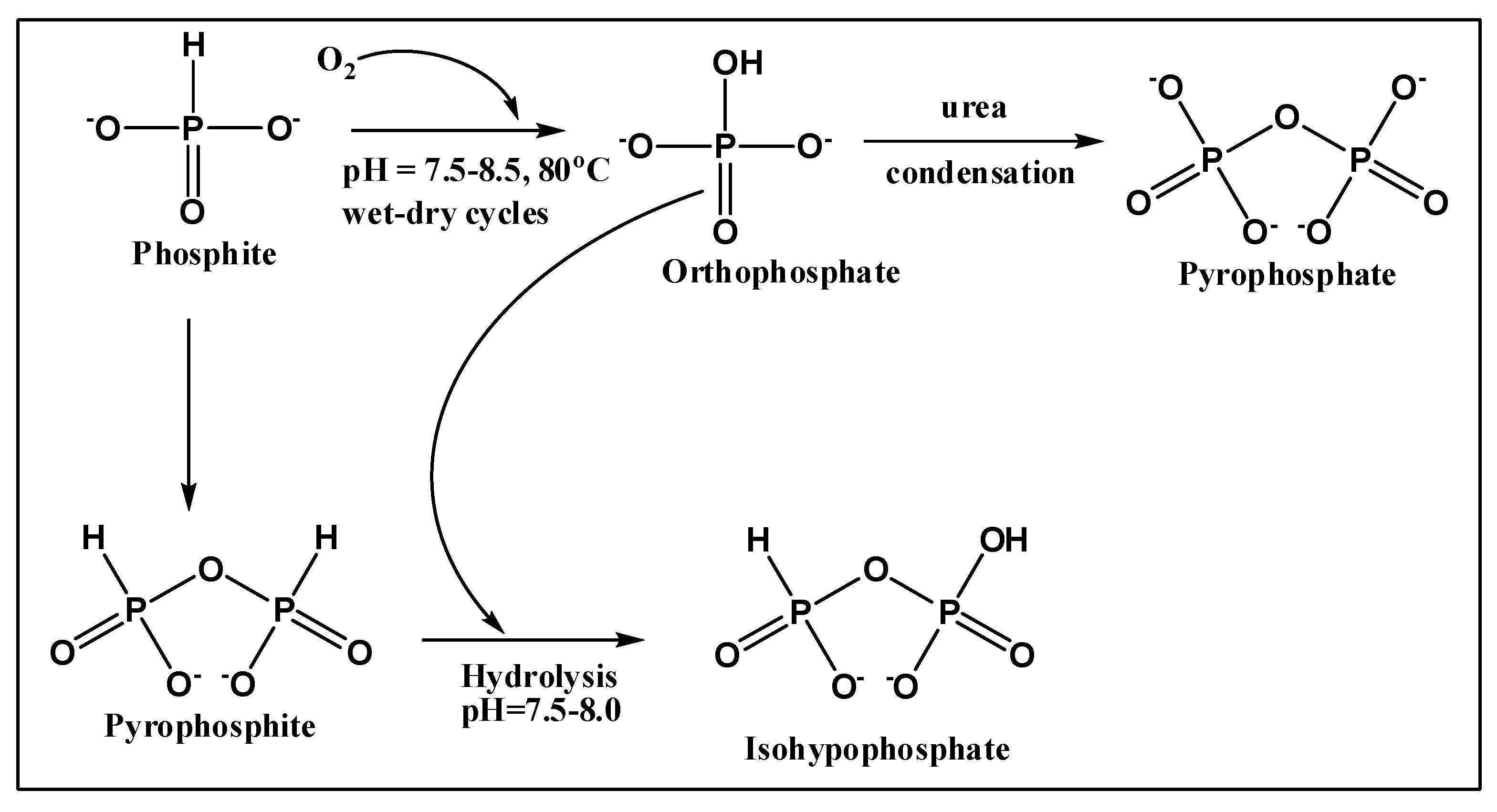
| Sample | Description |
|---|---|
| P3 | 0.1 g Na2HPO3 5H2O, 7 mL DDI water, 0.5 g urea, pH = 8.5 |
| P3-gyp | 0.1 g Na2HPO3 5H2O, 7 mL DDI water, 0.5 g urea, 0.2 g CaSO4·2H2O, pH = 8.5 |
| P3-MgCl2 | 0.1 g Na2HPO3 5H2O, 7 mL DDI water, 0.5 g urea, 0.2 g MgCl2, pH = 8.5 |
| P3-NaCl | 0.1 g Na2HPO3 5H2O, 7 mL DDI water, 0.5 g urea, 0.2 g NaCl, pH = 8.0 |
| P3-Am.Carb.1 | 0.1 g Na2HPO3 5H2O, 7 mL DDI water, 0.5 g urea, 0.4 g (NH4)2CO3, pH = 8.0 |
| P3-Am.Carb.2 | 0.1 g Na2HPO3 5H2O, 7 mL DDI water, 0.5 g urea, 0.8 g (NH4)2CO3, pH = 8.0 |
| P3-No.Ad. | 0.1 g Na2HPO3 5H2O, 7 mL DDI water, no additive, pH = 7.5 |
| P3-Kao. | 0.1 g Na2HPO3 5H2O, 7 mL DDI water, 0.5 g urea, 0.3 g kaolinite, pH = 8.5 |
| P3-SiO2 | 0.1 g Na2HPO3 5H2O, 7 mL DDI water, 0.5 g urea, 0.25 g white sand, pH = 8.5 |
| P3-IO | 0.1 g Na2HPO3 5H2O, 7 mL DDI water, 0.5 g urea, 0.25 g instant ocean, pH = 8.0 |
| P3-NH4Cl | 0.1 g Na2HPO3 5H2O, 7 mL DDI water, 0.5 g urea, 0.4 g NH4Cl, pH = 8.0 |
| HP3-No.Ad. | 0.1 g H3PO3, 7 mL DDI water, no additive, pH = 2 |
| HP3-U | 0.1 g H3PO3, 7 mL DDI water, 0.5 g urea, pH = 2 |
| P3-NWD | 0.1 g Na2HPO3 5H2O, 7 mL DDI water, 0.5 g urea, pH = 8.5 |
| P1-U | 0.1 g NaH2PO2·H2O, 7 mL DDI water, 0.5 g urea, pH = 6.0, NWD |
| P3-thio. | 0.1 g Na2HPO3 5H2O, 7 mL DDI water, 0.5 g thiourea, pH = 8.5 |
| Sample | Description |
|---|---|
| A | 0.1 g Na2HPO3 5H2O, 7 mL DDI water, 0.6 g uridine, pH = 8, 70–72 °C |
| B | 0.1 g Na2HPO3 5H2O, 7 mL DDI water, 0.5 g urea, 0.6 g uridine, pH = 8.5–9, 70–72 °C |
| C | 0.1 g Na2HPO3 5H2O, 7 mL DDI water, 0.8 g glycerol, pH = 7.5, 73–75 °C |
| D | 0.1 g Na2HPO3 5H2O, 7 mL DDI water, 0.5 g urea, 0.8 g glycerol, pH = 8.5–9, 73–75 °C |
| E | 0.1 g Na2HPO3 5H2O, 7 mL DDI water, 0.65 g adenosine, pH = 7.5, 78–80 °C |
| F | 0.1 g Na2HPO3 5H2O, 7 mL DDI water, 0.65 g adenosine, 0.5 g urea, pH = 8.5–9, 78–80 °C |
| Sample | Unreacted P | Phosphate | Isohypophosphate | Pyrophosphate | Pyrophosphite | PT |
|---|---|---|---|---|---|---|
| P3 | 37 | 11 | 9 | 25 | 18 | 52 |
| P3-gyp | 72 | 3 | 10 | BDL | 15 | 25 |
| P3-MgCl2 | 100 | BDL | BDL | BDL | BDL | BDL |
| P3-NaCl | 69 | 13 | 10 | BDL | 8 | 18 |
| P3-Am.Carb.1 | 39 | 1 | 6 | 1 | 53 | 60 |
| P3-Am.Carb.2 | 75 | 10 | 7 | 6 | 2 | 15 |
| P3-No.Ad. | 95 | 5 | BDL | BDL | BDL | BDL |
| P3-Kao. | 98 | 2 | BDL | BDL | BDL | BDL |
| P3-SiO2 | 83 | 1 | 5 | 3 | 8 | 16 |
| P3-IO | 98 | 2 | BDL | BDL | BDL | BDL |
| P3-NH4Cl | 95 | 5 | BDL | BDL | BDL | BDL |
| HP3-No.Ad. | 90 | 10 | BDL | BDL | BDL | BDL |
| HP3-U | 95 | 5 | BDL | BDL | BDL | BDL |
| P3-NWD | 5 | 1 | 8 | 4 | 82 | 94 |
| P3-thio. | 85.5 | 0.1 | BDL | BDL | 14.4 | 14.4 |
| Sample Name | Phosphite (Unreacted) | Orthophosphate | 5′-mono-PO3 | 5′-mono-PO4 | 2′-or 3′-mono-PO3 | 2′-or 3′-mono-PO4 | Nucleoside Diphosphite Species | Glycerol-1-PO3 | Glycerol-1-PO4 | Glycerol-2-PO3 | Glycerol-2-PO4 | Total Org. PO4 | Total Org. PO3 | TC-O-P |
|---|---|---|---|---|---|---|---|---|---|---|---|---|---|---|
| a | b | g | h | i | j | k | l | m | n | o | ||||
| A | 93 | 3 | 3 | BDL | 1 | BDL | BDL | ---- | ---- | ---- | ---- | BDL | 4 | 4 |
| B | 1 | BDL | 44 | BDL | 20 | BDL | 35 | ---- | ---- | ---- | ---- | BDL | 99 | 99 |
| C | 88 | 6.5 | ---- | ---- | ---- | ---- | ---- | 3.5 | BDL | 2 | BDL | BDL | 5.5 | 5.5 |
| D | 78 | 2 | ---- | ---- | ---- | ---- | 10 | 6 | 3 | 1 | 7 | 13 | 20 | |
| E | 98 | 1 | 1 | BDL | BDL | BDL | ---- | ---- | ---- | ---- | ---- | BDL | 1 | 1 |
| F | 44 | 0.5 | 36 | 1 | 18 | 0.5 | ---- | ---- | ---- | ---- | ---- | 1.5 | 54 | 55.5 |
Disclaimer/Publisher’s Note: The statements, opinions and data contained in all publications are solely those of the individual author(s) and contributor(s) and not of MDPI and/or the editor(s). MDPI and/or the editor(s) disclaim responsibility for any injury to people or property resulting from any ideas, methods, instructions or products referred to in the content. |
© 2023 by the authors. Licensee MDPI, Basel, Switzerland. This article is an open access article distributed under the terms and conditions of the Creative Commons Attribution (CC BY) license (https://creativecommons.org/licenses/by/4.0/).
Share and Cite
Gull, M.; Feng, T.; Cruz, H.A.; Krishnamurthy, R.; Pasek, M.A. Prebiotic Chemistry of Phosphite: Mild Thermal Routes to Form Condensed-P Energy Currency Molecules Leading Up to the Formation of Organophosphorus Compounds. Life 2023, 13, 920. https://doi.org/10.3390/life13040920
Gull M, Feng T, Cruz HA, Krishnamurthy R, Pasek MA. Prebiotic Chemistry of Phosphite: Mild Thermal Routes to Form Condensed-P Energy Currency Molecules Leading Up to the Formation of Organophosphorus Compounds. Life. 2023; 13(4):920. https://doi.org/10.3390/life13040920
Chicago/Turabian StyleGull, Maheen, Tian Feng, Harold A. Cruz, Ramanarayanan Krishnamurthy, and Matthew A. Pasek. 2023. "Prebiotic Chemistry of Phosphite: Mild Thermal Routes to Form Condensed-P Energy Currency Molecules Leading Up to the Formation of Organophosphorus Compounds" Life 13, no. 4: 920. https://doi.org/10.3390/life13040920
APA StyleGull, M., Feng, T., Cruz, H. A., Krishnamurthy, R., & Pasek, M. A. (2023). Prebiotic Chemistry of Phosphite: Mild Thermal Routes to Form Condensed-P Energy Currency Molecules Leading Up to the Formation of Organophosphorus Compounds. Life, 13(4), 920. https://doi.org/10.3390/life13040920










